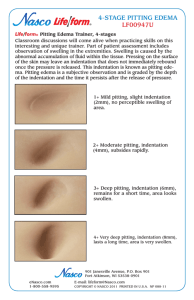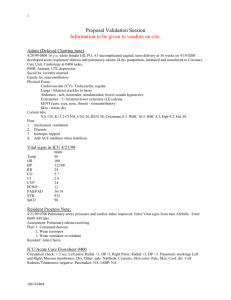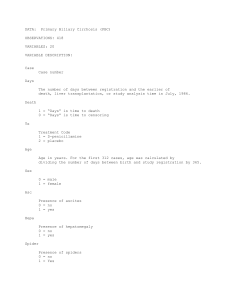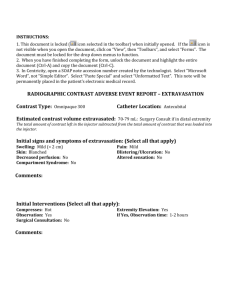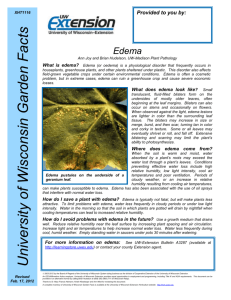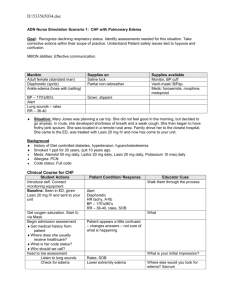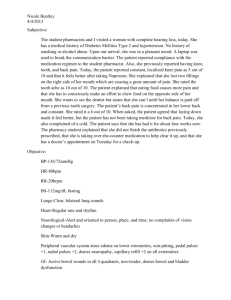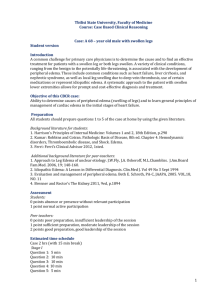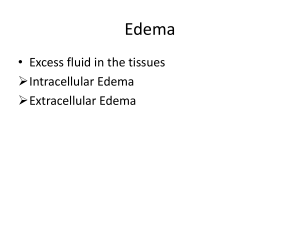Comparative Analysis of Diagnosis of Pitting Edema by Miro Device
advertisement
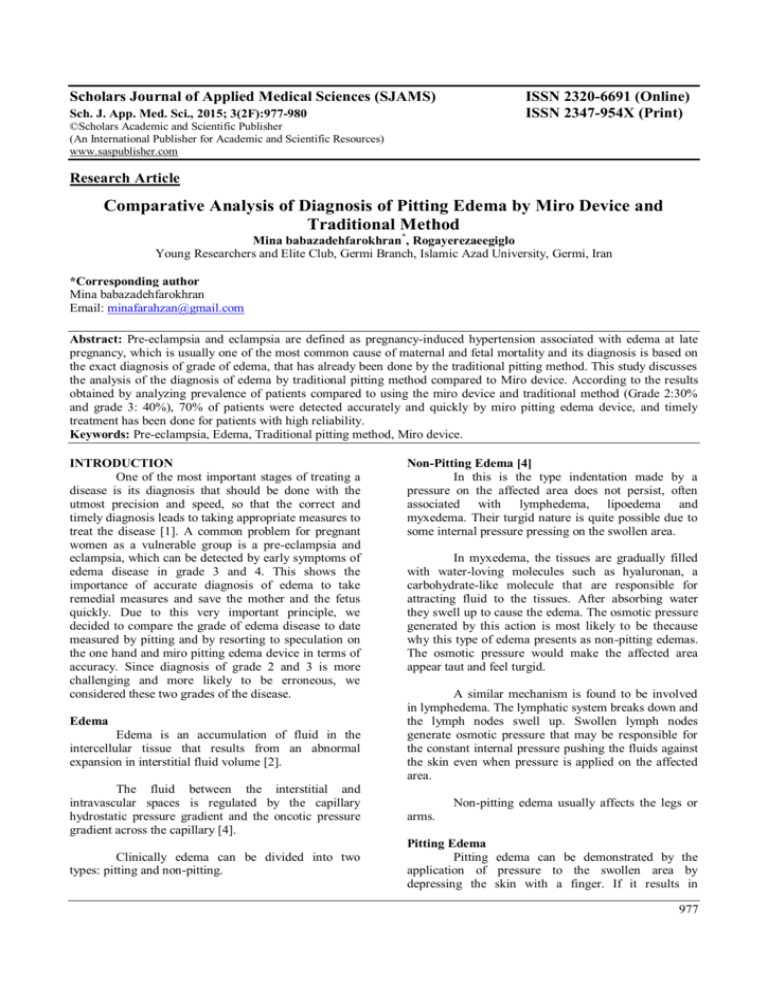
Scholars Journal of Applied Medical Sciences (SJAMS) Sch. J. App. Med. Sci., 2015; 3(2F):977-980 ISSN 2320-6691 (Online) ISSN 2347-954X (Print) ©Scholars Academic and Scientific Publisher (An International Publisher for Academic and Scientific Resources) www.saspublisher.com Research Article Comparative Analysis of Diagnosis of Pitting Edema by Miro Device and Traditional Method Mina babazadehfarokhran*, Rogayerezaeegiglo Young Researchers and Elite Club, Germi Branch, Islamic Azad University, Germi, Iran *Corresponding author Mina babazadehfarokhran Email: minafarahzan@gmail.com Abstract: Pre-eclampsia and eclampsia are defined as pregnancy-induced hypertension associated with edema at late pregnancy, which is usually one of the most common cause of maternal and fetal mortality and its diagnosis is based on the exact diagnosis of grade of edema, that has already been done by the traditional pitting method. This study discusses the analysis of the diagnosis of edema by traditional pitting method compared to Miro device. According to the results obtained by analyzing prevalence of patients compared to using the miro device and traditional method (Grade 2:30% and grade 3: 40%), 70% of patients were detected accurately and quickly by miro pitting edema device, and timely treatment has been done for patients with high reliability. Keywords: Pre-eclampsia, Edema, Traditional pitting method, Miro device. INTRODUCTION One of the most important stages of treating a disease is its diagnosis that should be done with the utmost precision and speed, so that the correct and timely diagnosis leads to taking appropriate measures to treat the disease [1]. A common problem for pregnant women as a vulnerable group is a pre-eclampsia and eclampsia, which can be detected by early symptoms of edema disease in grade 3 and 4. This shows the importance of accurate diagnosis of edema to take remedial measures and save the mother and the fetus quickly. Due to this very important principle, we decided to compare the grade of edema disease to date measured by pitting and by resorting to speculation on the one hand and miro pitting edema device in terms of accuracy. Since diagnosis of grade 2 and 3 is more challenging and more likely to be erroneous, we considered these two grades of the disease. Edema Edema is an accumulation of fluid in the intercellular tissue that results from an abnormal expansion in interstitial fluid volume [2]. The fluid between the interstitial and intravascular spaces is regulated by the capillary hydrostatic pressure gradient and the oncotic pressure gradient across the capillary [4]. Clinically edema can be divided into two types: pitting and non-pitting. Non-Pitting Edema [4] In this is the type indentation made by a pressure on the affected area does not persist, often associated with lymphedema, lipoedema and myxedema. Their turgid nature is quite possible due to some internal pressure pressing on the swollen area. In myxedema, the tissues are gradually filled with water-loving molecules such as hyaluronan, a carbohydrate-like molecule that are responsible for attracting fluid to the tissues. After absorbing water they swell up to cause the edema. The osmotic pressure generated by this action is most likely to be thecause why this type of edema presents as non-pitting edemas. The osmotic pressure would make the affected area appear taut and feel turgid. A similar mechanism is found to be involved in lymphedema. The lymphatic system breaks down and the lymph nodes swell up. Swollen lymph nodes generate osmotic pressure that may be responsible for the constant internal pressure pushing the fluids against the skin even when pressure is applied on the affected area. Non-pitting edema usually affects the legs or arms. Pitting Edema Pitting edema can be demonstrated by the application of pressure to the swollen area by depressing the skin with a finger. If it results in 977 Mina F et al., Sch. J. App. Med. Sci., 2015; 3(2F):977-980 indentation staying for some time after the release of the pressure, it can be referred to as pitting edema. The indentation made on the skin is due to the leaking of fluid out of the capillaries into the subcutaneous tissue. The extent and duration of the indentation are good indications of the severity of the pitting edema [4]. Pressure in any form, such as from the elastic in socks or tight clothing can induce pitting. They may also be caused by systemic diseases affecting various organ systems of the body such as heart, liver, and kidneys or by local conditions involving the affected extremities [4]. Sometimes pitting edema and non-pitting edema may occur without any underlying disease. This condition is known as idiopathic edema. This is common in women during their pre-menstrual or premenopausal period, occurring in legs and feet [4]. To date, the edema was diagnosed by traditional pitting method and resorting to speculation. However, using miro edema diagnosis device, was it is measured accurately, quickly and easily. The accumulation of fluid occurs when local or systemic conditions disrupt this equilibrium leading to increased capillary hydrostatic pressure, increased plasma volume, decreased plasma oncotic pressure (hypoalbuminemia), increased capillary permeability, or lymphatic obstruction [2]. Causes of edema that are generalized to the whole body may result in the formation of edema in multiple organs and peripherally such as severe heart failure can cause pulmonary edema, pleural effusions, ascites and peripheral edema [5]. 1+ 2+ 3+ 4+ 1+ 2+ 3+ 4+ Although a low plasma oncotic pressure is widely reported for the edema of nephrotic syndrome, edema may occur before there is any significant protein in the urine (proteinuria) or fall in plasma protein level [6]. Edemas often occur during the late stages of pregnancy in some women. Edemas during pregnancy usually occur in the lower part of the leg. It is more common in women with history of pulmonary problems or poor circulation also intensified if arthritis is already present. Women already having arthritis most often have to seek medical help for pain caused from overreactive swelling [5]. Pre-eclampsia is defined as pregnancy-induced hypertension associated with proteinuria and/or edema or both. and if being added by convulsions or seizure, it is called eclampsia [7]. Pre-eclampsia occurs in about 5-8 percent of pregnancies. If remain undetected, preeclampsia can lead to eclampsia which has been reported as one of the top five causes of maternal and infant illness and death, causing an estimated 13% of all maternal deaths worldwide [8]. Pre-eclampsia and eclampsia are causes of almost more than 50 thousand maternal mortality annually around the world [9, 10]. Therefore, this study discusses the analysis of the diagnosis of edema by traditional pitting method compared to miro device. Therefore, pitting edemas are graded by this simple examination. The table below explains the four grades of pitting edema. Table 1: Pitting Edema – measurement [11] Barely detectable impression when finger is pressed into skin. Slight indentation. 15 seconds to rebound Deeper indentation. 30 seconds to rebound. > 30 seconds to rebound. Table 2: Pitting Edema – measurement [12] 2mm depression, barely detectable. Immediate rebound. 4mm deep pit. A few seconds to rebound. 6mm deep pit. 10-12 seconds to rebound. 8mm: very deep pit. >20 seconds to rebound. METHODOLOGY This descriptive-analytical study conducted on 30 women with suspected edema grades 2 and 3who referred to midwife (Mrs. Rezaee with midwifery license of 17582) by examining the frequency of disease. 978 Mina F et al., Sch. J. App. Med. Sci., 2015; 3(2F):977-980 Edema was examined in patients with both traditional methods and mirodiagnosis device. Then, Grade 2 Grade 3 Results ever patient was sent for proteinuria albumin test to determine the control group. According to the results: Table 2: Frequency Frequency 12 18 30 Relative frequency 40 60 100 Investigate patients with edema grade 2: Plus ++ 12 Table 3: Edema grade 2 Frequency Traditional pitting method 3 Miro edema diagnosis device 9 According to Table 2, edema grade 2 was diagnosed in 12 out of 30 cases by proteinuria tests. Among 12 cases, 3 were detected by traditional pitting method and 9 by miro pitting edema diagnosis device. Relative frequency for all patients 10% 30% Comparing statistics of10% in the traditional method and 30% in using miro device, the high-precision and low error probability of miro device can be realized. Investigate patients with edema grade 3 Plus ++ 18 Tale 4: Edema grade 3 Frequency Traditional pitting method 6 Miro edema diagnosis device 12 According to Table 2, edema grade 2 was diagnosed in 18 out of 30 cases by proteinuria tests. Among 18 cases, 6 were detected by traditional pitting method and 12 by miro pitting edema diagnosis device. Comparing statistics of 20% in the traditional method and 40% in using miro device, the high-precision and low error probability of miro device can be realized. RESULTS AND DISCUSSION According to studies conducted for accurate diagnosis of edema grade 2 and 3 which has high sensitivity due to the different treatments and preeclampsia and eclampsia risk for patients on the one hand, and requires lots of time for referring patients to laboratories for diagnosis and treatment on the other hand, the traditional method can be dangerous for mother and fetus. In addition, the traditional method needs a very expert and experienced midwife. However, there is always a risk of misdiagnosis, since the process in based on speculation and guess. Nonetheless, according to the results obtained (Grade 2: 30% and grade 3: 40%), 70% of patients were detected accurately and quickly by miro pitting edema device, and timely treatment has been done for patients with high reliability. CONCLUSION According to the results 70% of patients were detected accurately and quickly by miro pitting edema device, and timely treatment has been done for patients with high reliability. Relative frequency for all patients 20% 40% REFERENCES 1. Norouzi A; Evaluation of maternal, fetal and neonatal complications in multiparous women referring to Fatima Zahra maternity hospital, Bushehr in 1992-1993. Master’s thesis. Tehran, Shahid Beheshti Medical University, 1993: 60-61. 2. Trayes KP, Studdiford JS, Pickle S, Tully AS; Edema: Diagnosis and management. Am Fam Physician, 2013; 88(2): 102-110. 3. Bhattacharya M, Alper SL; Pharmacology of volume regulation. In Golan DE, Tashjian AH, Armstrong EJ; Principles of Pharmacology: The Pathophysiologic Basis of Drug Therapy. Lippincott Williams & Wilkins, 2011: 333. 4. Chase B; Pitting vs Non Pitting Edema. http://www.progressivehealth.com/pitting-andnon-pitting-edema.htm 5. Edema. Available from http://en.wikipedia.org/wiki/Edema 6. Palmer BF, Alpern RJ; Pathogenesis of edema formation in the nephrotic syndrome. Kidney Int Suppl., 1997; 59: S21–27. 7. Hypertension in Pregnancy. Available from http://www.patient.co.uk/doctor/hyperten sion-in-pregnancy 8. Preeclampsia Fact Sheet. Available from https://www.preeclampsia.org/pdf/Preeclampsi a%20Fact%20sheet%20v2.pdf 9. Lopez-Jaramillo P, Casas JP, Serrano N; Preeclampsia: from epidemiological 979 Mina F et al., Sch. J. App. Med. Sci., 2015; 3(2F):977-980 observations to molecular mechanisms. Braz J Med Biol Res., 2001; 34(10): 1227–1235. 10. Which anticonvulsant for women with eclampsia? Evidence from the collaborative eclampsia trial. Lancet, 1995; 345(8963): 1455–1463. 11. O’Sullivan SB, Schmitz TJ; Physical rehabilitation: assessment and treatment, 5th edition, F. A. Davis Company, Philadelphia, 2007: 659 12. Hogan M; Medical-surgical nursing. 2nd edition, Prentice Hall, Salt Lake City, 2007. 980
